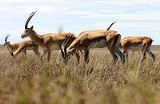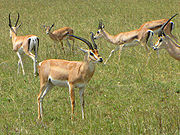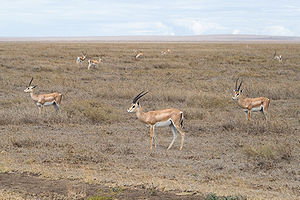
Grant's Gazelle
Encyclopedia
The Grant's gazelle is a species of gazelle
. Its populations are distributed from northern Tanzania
to southern Sudan
and Ethiopia
, and from the Kenya
n coast to Lake Victoria
. Its Swahili name is Swala Granti.
Gazelle (N. soemmerringii) and Thomson’s
Gazelle (Eudorcas thomsonii) with Soemmering’s gazelle being the closest relative out of the two species. Grant's gazelle shows high genetic variation among its populations even though there is no geographic isolation. The differentiation of the species may have evolved during repeated expansion and contraction of arid habitats during the late Pleistocene
era in which populations were possibly isolated. Grant's gazelle was formerly considered a member of the genus Gazella within the subgenus Nanger before Nanger was elevated to genus status.
 The Grant's gazelle is found in East Africa
The Grant's gazelle is found in East Africa
and lives in open grass plains and frequently found in shrublands; it avoids areas that have high grass where the visibility of predators is compromised. They also occur in semi-arid
areas as well, and are relatively arid-adapted, relying on more "browse" or leafy material during dry seasons in order to supplement their intake of water. They are migratory animals but travel in the opposite direction of most of the other ungulates like Thompson's gazelles, zebra
s and wildebeest
s which are more water dependant. They can subsist on vegetation in waterless, semiarid areas. Here they face little competition.
 Grant’s gazelles are generally mixed feeders that both browse and graze. Their average diet consists of 65.8% browse and 34.3% graze. Rainfall in their habitats seem to be the determinant of their diets. The Grant's gazelle's diet may also be responsible for the slow growth rates in the browsed plots. They get most of their moisture from the plants they eat so they don’t have to drink water often. Thus they can stay on the plains long after the rains end. From July to September, gazelles move deep into dense brush and wait for the next rains. They will eat red oats and small crunchy plants, which are avoided by the other ungulates. This allows the gazelles to survive in the brush during the dry season. Grant’s gazelles eat mainly dicotyledon
Grant’s gazelles are generally mixed feeders that both browse and graze. Their average diet consists of 65.8% browse and 34.3% graze. Rainfall in their habitats seem to be the determinant of their diets. The Grant's gazelle's diet may also be responsible for the slow growth rates in the browsed plots. They get most of their moisture from the plants they eat so they don’t have to drink water often. Thus they can stay on the plains long after the rains end. From July to September, gazelles move deep into dense brush and wait for the next rains. They will eat red oats and small crunchy plants, which are avoided by the other ungulates. This allows the gazelles to survive in the brush during the dry season. Grant’s gazelles eat mainly dicotyledon
s during the dry season and grass in the wet season.
The most common predators of the Grant's gazelle are cheetah
s and wild dog
s. Humans also tend to hunt gazelles. In the Serengeti
, Grant's gazelle is a prey item for cheetahs but Thomson's gazelle
is more preferred. However, in Nairobi National Park
, Grant's gazelle is preferred over Thomson's gazelle making it an important resource to the cheetah. Jackal
s are major predators of fawns.
Bachelor groups are made up of adolescent and non-territory holding bucks. Any new members must perform intimidation displays to enter the group. However bachelor groups tend to be very loose and members can leave whenever they want. The larger, older males with thick horns have the best chance of establishing a territory. Conflicts between adult males are usually solved with intimidation displays. The bucks circle each other and swing their necks from side to side, displaying their neck power. Neck strength is important in an actual fight and the male that can’t keep up yields. Gazelles of nearly equal neck strength are more likely to engage in actual combat. Fighting occurs in young bucks more often than older ones. Dominant bucks can simply run off subordinates rather than having to display to them.
to determine if she is in estrous. If she is, he will continue to follow her. The female will lift her tail, signaling that she is ready to mate and the male will copulate her. The gestation period for the gazelle lasts for 198 days. Births peak in January and February. A doe will leave her herd and find a well hidden place to give birth. Afterwards, the female eats the afterbirth and other fluids to keep the fawn clean and scentless. Females that have recently given birth will stay together for protection. The does nurse their fawns four times a day. Fawns are immobile for the first few days so the mother stays close by. When the fawn can walk, it leaves with its mother to find a herd. Around thus time, fawns will associate with one another in peer groups. A gazelle is weaned at six months but will continue to associate with its mother until adolesence.
and Ngorongoro Conservation Area
in Tanzania, and Lake Turkana National Parks
in Kenya. Estimates of the population range from 140,000 to 350,000. While certain areas have stable popualtions, overall the population trend is going downward.
Gazelle
A gazelle is any of many antelope species in the genus Gazella, or formerly considered to belong to it. Six species are included in two genera, Eudorcas and Nanger, which were formerly considered subgenera...
. Its populations are distributed from northern Tanzania
Tanzania
The United Republic of Tanzania is a country in East Africa bordered by Kenya and Uganda to the north, Rwanda, Burundi, and the Democratic Republic of the Congo to the west, and Zambia, Malawi, and Mozambique to the south. The country's eastern borders lie on the Indian Ocean.Tanzania is a state...
to southern Sudan
Sudan
Sudan , officially the Republic of the Sudan , is a country in North Africa, sometimes considered part of the Middle East politically. It is bordered by Egypt to the north, the Red Sea to the northeast, Eritrea and Ethiopia to the east, South Sudan to the south, the Central African Republic to the...
and Ethiopia
Ethiopia
Ethiopia , officially known as the Federal Democratic Republic of Ethiopia, is a country located in the Horn of Africa. It is the second-most populous nation in Africa, with over 82 million inhabitants, and the tenth-largest by area, occupying 1,100,000 km2...
, and from the Kenya
Kenya
Kenya , officially known as the Republic of Kenya, is a country in East Africa that lies on the equator, with the Indian Ocean to its south-east...
n coast to Lake Victoria
Lake Victoria
Lake Victoria is one of the African Great Lakes. The lake was named for Queen Victoria of the United Kingdom, by John Hanning Speke, the first European to discover this lake....
. Its Swahili name is Swala Granti.
Taxonomy and genetics
Grant's gazelle is more genetically related to Soemmerring’sSoemmerring's Gazelle
Soemmerring's Gazelle is a gazelle that lives in eastern Africa.-Subspecies:* Somali Soemmerring Gazelle Nanger soemmeringii berberana...
Gazelle (N. soemmerringii) and Thomson’s
Thomson's Gazelle
The Thomson's gazelle is one of the best-known gazelles. It is named after explorer Joseph Thomson and, as a result, is sometimes referred to as a "tommie"...
Gazelle (Eudorcas thomsonii) with Soemmering’s gazelle being the closest relative out of the two species. Grant's gazelle shows high genetic variation among its populations even though there is no geographic isolation. The differentiation of the species may have evolved during repeated expansion and contraction of arid habitats during the late Pleistocene
Pleistocene
The Pleistocene is the epoch from 2,588,000 to 11,700 years BP that spans the world's recent period of repeated glaciations. The name pleistocene is derived from the Greek and ....
era in which populations were possibly isolated. Grant's gazelle was formerly considered a member of the genus Gazella within the subgenus Nanger before Nanger was elevated to genus status.
Subspecies
- Nanger granti brighti (Thomas, 1901) – Bright's Gazelle
- Nanger granti granti (Brooke, 1872) – Southern Grant's Gazelle
- Nanger granti lacuum (Neumann, 1906) – Northern Grant's Gazelle
- Nanger granti petersi (Günther, 1884) – Peter's Gazelle
- Nanger granti robertsi (Thomas, 1903) – Robert's Gazelle
Appearance
The Grant's Gazelle stands 75 centimetre up to the shoulder and weighs 45 kilogram. Its coat is a beige orange on the back with a white belly. The Grant's Gazelle looks similar to a Thomson's Gazelle except it has lyre-shaped horns which are stout at the base, clearly ringed and measuring 45–81 cm (18–32 in) long. The subspecies are segregated by different morphological characters such as; horn shape and slight differences in coat colour. These differences are not indicative of ecological separation as with some species. They can reach running speeds of up to 80 kilometre per hour.Ecology

East Africa
East Africa or Eastern Africa is the easterly region of the African continent, variably defined by geography or geopolitics. In the UN scheme of geographic regions, 19 territories constitute Eastern Africa:...
and lives in open grass plains and frequently found in shrublands; it avoids areas that have high grass where the visibility of predators is compromised. They also occur in semi-arid
Semi-arid
A semi-arid climate or steppe climate describes climatic regions that receive precipitation below potential evapotranspiration, but not extremely...
areas as well, and are relatively arid-adapted, relying on more "browse" or leafy material during dry seasons in order to supplement their intake of water. They are migratory animals but travel in the opposite direction of most of the other ungulates like Thompson's gazelles, zebra
Zebra
Zebras are several species of African equids united by their distinctive black and white stripes. Their stripes come in different patterns unique to each individual. They are generally social animals that live in small harems to large herds...
s and wildebeest
Wildebeest
The wildebeest , also called the gnu is an antelope of the genus Connochaetes. It is a hooved mammal...
s which are more water dependant. They can subsist on vegetation in waterless, semiarid areas. Here they face little competition.

Dicotyledon
The dicotyledons, also known as dicots, are a group of flowering plants whose seed typically has two embryonic leaves or cotyledons. There are around 199,350 species within this group...
s during the dry season and grass in the wet season.
The most common predators of the Grant's gazelle are cheetah
Cheetah
The cheetah is a large-sized feline inhabiting most of Africa and parts of the Middle East. The cheetah is the only extant member of the genus Acinonyx, most notable for modifications in the species' paws...
s and wild dog
African Wild Dog
Lycaon pictus is a large canid found only in Africa, especially in savannas and lightly wooded areas. It is variously called the African wild dog, African hunting dog, Cape hunting dog, painted dog, painted wolf, painted hunting dog, spotted dog, or ornate wolf...
s. Humans also tend to hunt gazelles. In the Serengeti
Serengeti National Park
The Serengeti National Park is a large national park in Serengeti area, Tanzania. It is most famous for its annual migration of over one and a half million white bearded wildebeest and 250,000 zebra...
, Grant's gazelle is a prey item for cheetahs but Thomson's gazelle
Thomson's Gazelle
The Thomson's gazelle is one of the best-known gazelles. It is named after explorer Joseph Thomson and, as a result, is sometimes referred to as a "tommie"...
is more preferred. However, in Nairobi National Park
Nairobi National Park
Nairobi National Park is a national park in Kenya. Established in 1946, the national park was Kenya's first. It is located approximately 7 kilometres south of the centre of Nairobi, Kenya's capital city, with only a fence separating the park's wildlife from the metropolis. Nairobi's skyscrapers...
, Grant's gazelle is preferred over Thomson's gazelle making it an important resource to the cheetah. Jackal
Jackal
Although the word jackal has been historically used to refer to many small- to medium-sized species of the wolf genus of mammals, Canis, today it most properly and commonly refers to three species: the black-backed jackal and the side-striped jackal of sub-Saharan Africa, and the golden jackal of...
s are major predators of fawns.
Lifecycle
The Grant's gazelle is a gregarious, territorial, and migratory species. The home ranges of does overlap with that of the bucks. Only male gazelles are territorial. Male gazelles will herd all females that cross their territories. When the females are in estrous, they are strongly guarded by the dominant male who prevents other males from mating with them. Any doe that tries to leave is aggressively herded back. Most of the time, the buck’s simple stance in relation to her is enough to keep the female from leaving.Bachelor groups are made up of adolescent and non-territory holding bucks. Any new members must perform intimidation displays to enter the group. However bachelor groups tend to be very loose and members can leave whenever they want. The larger, older males with thick horns have the best chance of establishing a territory. Conflicts between adult males are usually solved with intimidation displays. The bucks circle each other and swing their necks from side to side, displaying their neck power. Neck strength is important in an actual fight and the male that can’t keep up yields. Gazelles of nearly equal neck strength are more likely to engage in actual combat. Fighting occurs in young bucks more often than older ones. Dominant bucks can simply run off subordinates rather than having to display to them.
Reproduction
Grant’s gazelles sexually mature at 18 months. Territory-holding bucks mate more than ones in bachelor groups. The courting ritual begins with a buck following a doe, waiting for her to urinate. When she does, the male does the flehmenFlehmen response
The flehmen response , also called the flehmen position, flehmen reaction, flehming, or flehmening , is a particular type of curling of the upper lip in ungulates, felids, and many other mammals, which facilitates the transfer of pheromones and other scents into the vomeronasal organ, also called the...
to determine if she is in estrous. If she is, he will continue to follow her. The female will lift her tail, signaling that she is ready to mate and the male will copulate her. The gestation period for the gazelle lasts for 198 days. Births peak in January and February. A doe will leave her herd and find a well hidden place to give birth. Afterwards, the female eats the afterbirth and other fluids to keep the fawn clean and scentless. Females that have recently given birth will stay together for protection. The does nurse their fawns four times a day. Fawns are immobile for the first few days so the mother stays close by. When the fawn can walk, it leaves with its mother to find a herd. Around thus time, fawns will associate with one another in peer groups. A gazelle is weaned at six months but will continue to associate with its mother until adolesence.
Status
The Grant’s gazelle is still a common species despite having being eradicated in certain areas. Major threats have been habitat destruction and hunting. The gazelle’s status as an unthreatened species is dependent on protection of the national parks and reserves it lives in. Examples of such parks include Serengeti National ParkSerengeti National Park
The Serengeti National Park is a large national park in Serengeti area, Tanzania. It is most famous for its annual migration of over one and a half million white bearded wildebeest and 250,000 zebra...
and Ngorongoro Conservation Area
Ngorongoro Conservation Area
The Ngorongoro Conservation Area is a conservation area and a UNESCO World Heritage Site situated west of Arusha in the Crater Highlands area of Tanzania. The conservation area is administered by the Ngorongoro Conservation Area Authority, an arm of the Tanzanian government, and its boundaries...
in Tanzania, and Lake Turkana National Parks
Lake Turkana National Parks
Lake Turkana National Parks is a group of three national parks located in Kenya. It was inscribed as a UNESCO World Heritage Site in 1997 and expanded in 2001. Reasons for the park's importance include its use as a stopping point for migratory birds, as a breeding ground for the Nile crocodile,...
in Kenya. Estimates of the population range from 140,000 to 350,000. While certain areas have stable popualtions, overall the population trend is going downward.

